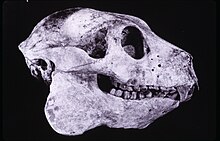| Sloth lemur Temporal range:
| |
|---|---|

| |
| Babakotia radofilai skull | |
| Scientific classification | |
| Domain: | Eukaryota |
| Kingdom: | Animalia |
| Phylum: | Chordata |
| Class: | Mammalia |
| Order: | Primates |
| Suborder: | Strepsirrhini |
| Superfamily: | Lemuroidea |
| Family: | †Palaeopropithecidae Tattersall, 1973[1] |
| Genera | |
The sloth lemurs (Palaeopropithecidae) comprise an extinct family of lemurs that includes four genera.[2][3] The common name can be misleading, as members of Palaeopropithecidae were not closely related to sloths. This clade has been dubbed the ‘‘sloth lemurs’’ because of remarkable postcranial convergences with South American sloths.[4] Despite postcranial similarities, the hands and feet show significant differences. Sloths possess long, curved claws, while sloth lemurs have short, flat nails on their distal phalanges like most primates.[5]
- ^ McKenna, MC; Bell, SK (1997). Classification of Mammals: Above the Species Level. Columbia University Press. p. 335. ISBN 978-0-231-11013-6.
- ^ Mittermeier, Russell A.; et al. (2006). Lemurs of Madagascar (2nd ed.). Conservation International. pp. 44–45. ISBN 978-1-881173-88-5.
- ^ Nowak, Ronald M. (1999). Walker's Primates of the World. Johns Hopkins University Press. pp. 89–91. ISBN 978-0-8018-6251-9.
- ^ Rafferty, KL; Teaford, MF; Jungers, WL (November 2002). "Molar microwear of subfossil lemurs: improving the resolution of dietary inferences". J. Hum. Evol. 43 (5): 645–57. Bibcode:2002JHumE..43..645R. doi:10.1006/jhev.2002.0592. PMID 12457853.
- ^ Jungers, William L.; Godfrey, Laurie R.; Simons, Elwyn L.; Chatrath, Prithijit S. (1997). "Phalangeal curvature and positional behavior in extinct sloth lemurs (Primates, Palaeopropithecidae)". Proceedings of the National Academy of Sciences of the United States of America. 94 (22): 11998–12001. Bibcode:1997PNAS...9411998J. doi:10.1073/pnas.94.22.11998. JSTOR 43006. PMC 23681. PMID 11038588.